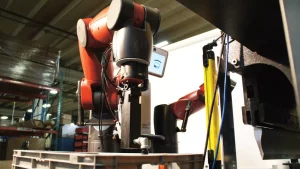In the manufacturing environment, there have been many press brake operating jobs that require skilled workers to perform very simple tasks, such as bending one small part after another, over and over again. Businesses are deploying their highly skilled operators on projects that are very simple and tedious when they could be utilized for highly complex and specialized work. At Atlas, we took a unique approach to this problem. Instead of having skilled operators perform the monotonous simple work, why not a collaborative robot? This is where our robot Baxter became engaged with operating a press brake.
Over the past couple of years, collaborative robots have gathered attention from manufacturing companies like Atlas. The operator and robot collaborate and use a system called behavior-based robotics. The programmer teaches the collaborative robot specific movements and from that, the robot becomes aware of its surroundings and decides the best path to complete its task. If they touch something out of the ordinary, it will stop to prevent creating scrap. Also, collaborative robots can sense if a person is nearby and will slow down the process for safety precautions.
When the collaborative robot was first introduced to the manufacturing industry, we were a bit skeptical; it was slow-moving and did come with a few drawbacks. Over time, however, the technology has progressed. According to Zach Zurbey, our continuous improvement leader, “We saw the updated systems and it became quicker, more agile, and repeatable.” This is when Atlas decided to purchase Baxter from Rethink Robotics. The improvement team took on the role to figure out how exactly to use Baxter.




After analyzing how the collaborative robot performed through the summer, we found a place for Baxter in our press brake department. We had just received an order that included a large volume of very simple brackets. Rather than consuming the time of our press brake operators, we could collaborate with our robot to get this job done, while allowing operators to work on more complicated projects.
Since the implementation of Baxter, we have kept him working on simple tasks. We keep Baxter busy with projects that have three or fewer bends. If the project exceeds this constraint, we move the task to skilled operators to avoid scrap.
Baxter has proven that collaborative robots can help with efficiency in the workplace and the technology continues to improve. One of our best press brake operators trains Baxter, programs his press brake, and works on the initial setup. When he is not around, other press brake operators will check up on Baxter and monitor his work. Because of Baxter, our very skilled press brake operators can now focus on more complicated projects rather than spending 8-12 hours a day working on simple, tedious projects.
Read more about Baxter here!
